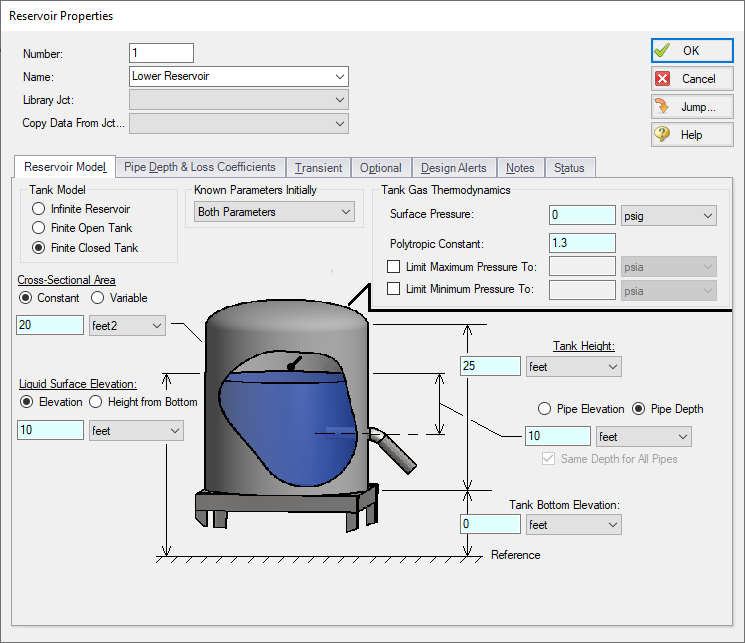Entering Reservoir Volume Data
(XTS Module Only) When running AFT Fathom in Steady Only mode (or without the XTS module), each reservoir junction is considered an infinite reservoir. This means that the liquid heights and surface pressures entered are constant. When running transients, reservoirs can be either infinite or finite. Similar to Steady Only mode, an infinite reservoir maintains its level during the transient. The differences are discussed below and summarized in Table 1.
Table 1: Various possible inputs with infinite and finite Reservoir junctions

Infinite Reservoirs
Infinite reservoirs refer to a massive body of fluid whose surface level does not change appreciably as a result of liquid inflow or outflow during the time frame of the simulation. An example is a large lake or the ocean. Figure 1 shows a Reservoir junction modeled as infinite.
Finite Reservoirs
Finite reservoirs (also called finite tanks) refer to a body of fluid which is small enough that its surface level changes significantly during the time frame of the simulation as a result of liquid inflow or outflow. An example is a tank which drains as the simulation progresses. Tanks can have constant cross-section (e.g., a pure vertical cylinder) or tank cross-section can change with height. When the cross-section changes, the tank volume at each height data point must be specified.
Finite tanks can further be broken down into open or closed tanks.
-
Finite open tanks - Finite open tanks are open to the atmosphere or some other fixed surface pressure. Typically open tanks have a constant surface pressure with time, although users have the latitude to pre-specify time varying surface pressure. Figure 2 shows a Reservoir junction modeled as a finite open tank.
-
Finite closed tanks - Finite closed tanks are tanks in which, as the liquid level changes, the gas above the liquid expands or contracts and hence its pressure changes according to the gas thermodynamic laws. For closed tanks the user specifies the initial liquid level and gas pressure, but during the simulation all gas pressure and liquid levels are calculated by AFT Fathom. Figure 3 shows a Reservoir junction modeled as a finite closed tank.
In some cases the liquid level may not be known initially when modeling finite tanks. An example would be a vertical standpipe. At time zero the net flow at the standpipe would be balanced, and the liquid surface would find its own level (this would equal the local hydraulic gradeline). Hence the initial liquid level would be calculated based on equilibrium.
However, under transient conditions the liquid level will change, and the liquid volume in the standpipe can significantly affect pipeline behavior.
This is the purpose of the features in the Known Parameters Initially area (see Figure 2). By default, both the initial liquid level and initial surface pressure are assumed known. If you want to model one of them as unknown initially, select the desired parameter from the drop-down. If the surface pressure is selected as unknown initially, it functions similarly to the unknown liquid level except initial equilibrium surface pressure would be calculated.
This feature only affects the calculation at the initial “zero” time step. For all other time steps, the junction behaves the same as a junction in which the liquid level and surface pressure are known initially.

Figure 1: Reservoir junction modeled as infinite

Figure 2: Reservoir junction modeled as finite open

Figure 3: Reservoir junction modeled as finite closed



